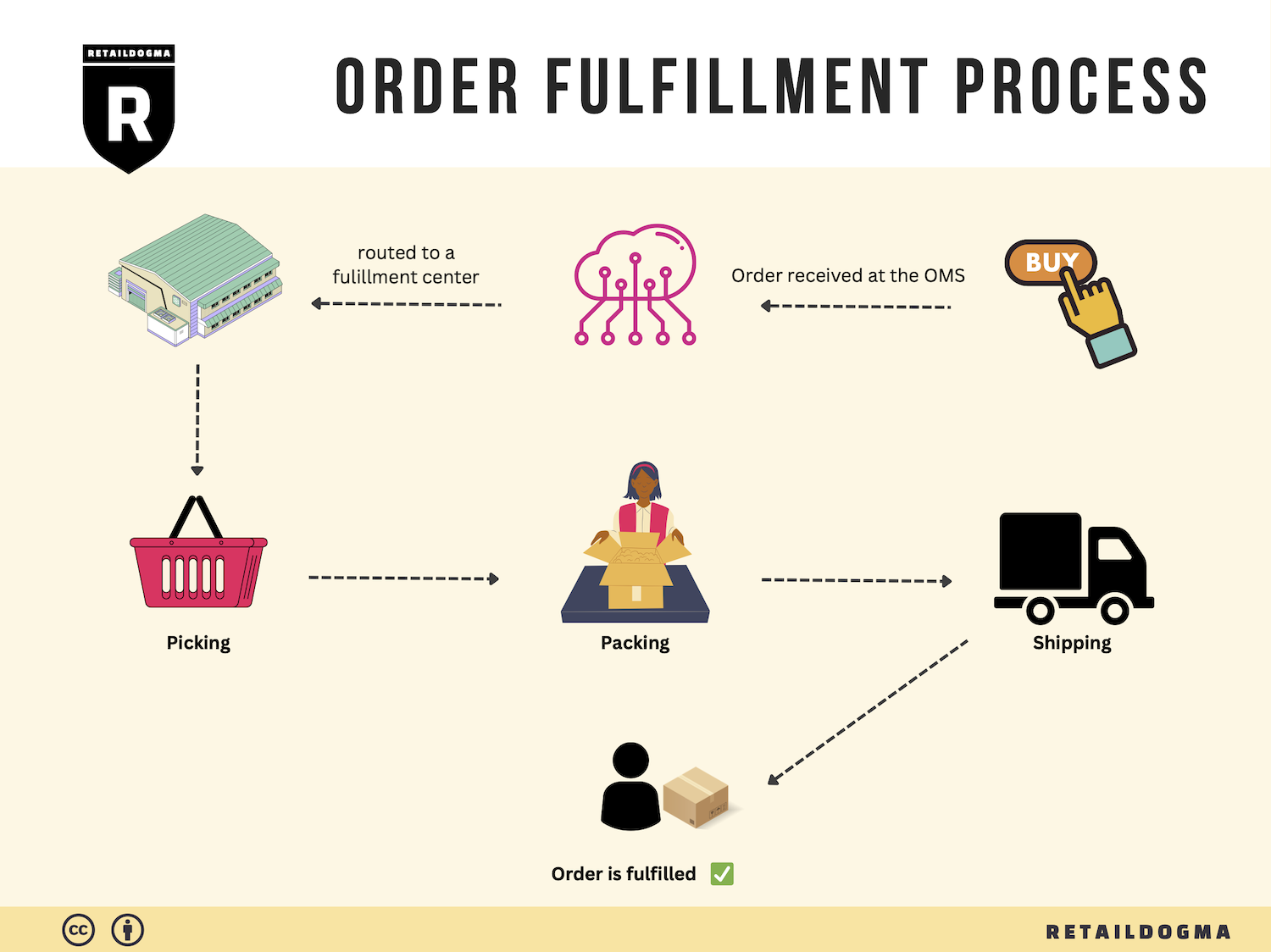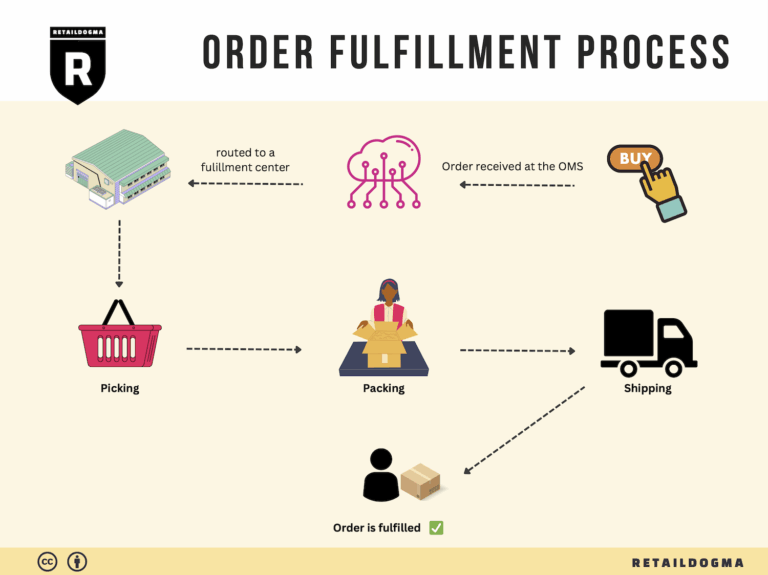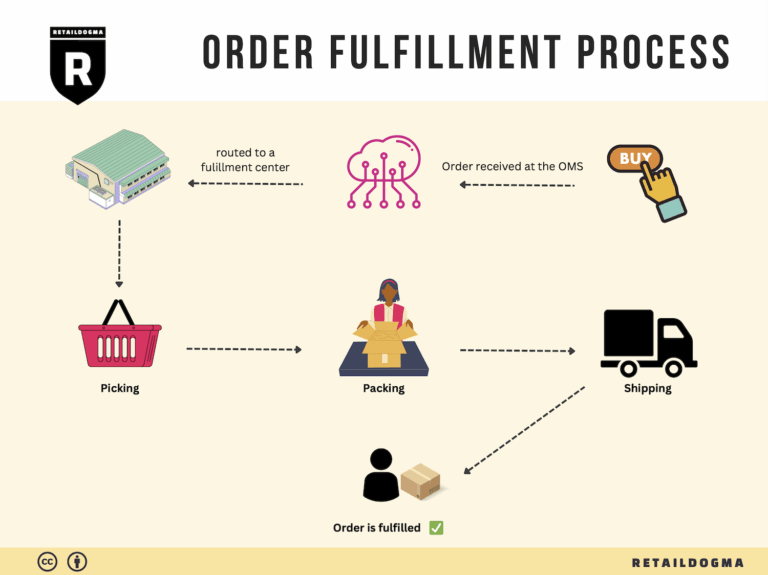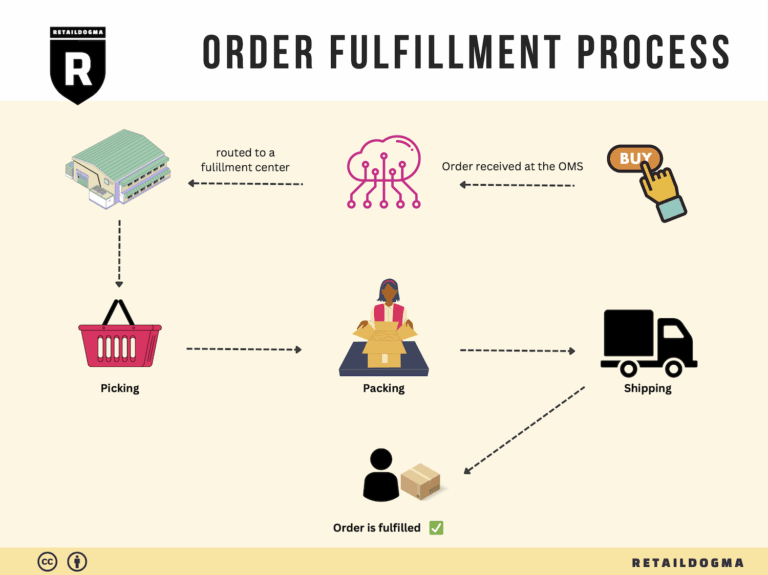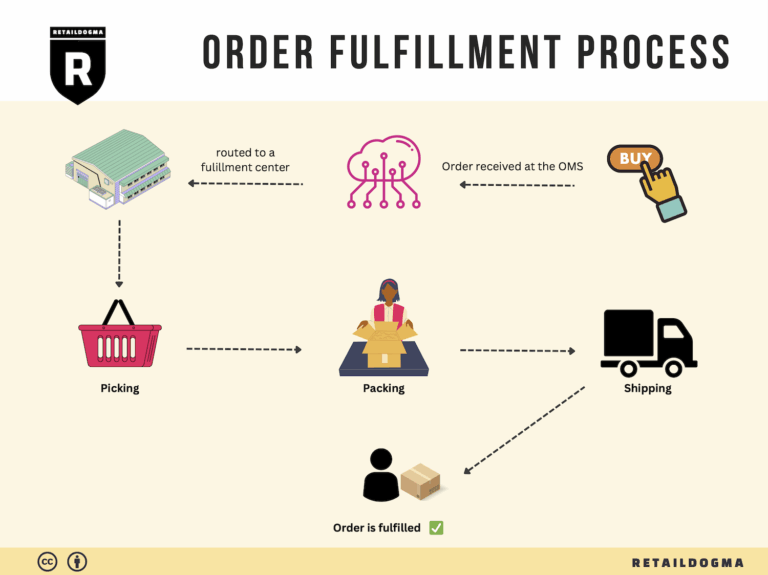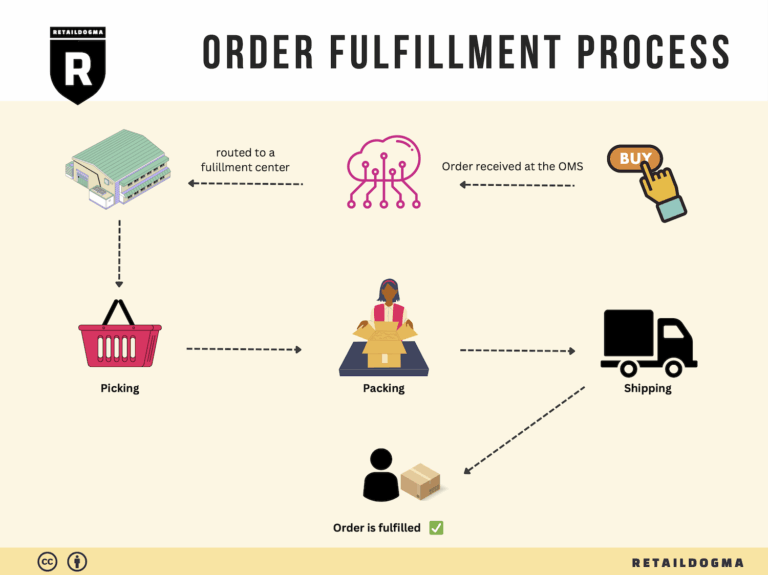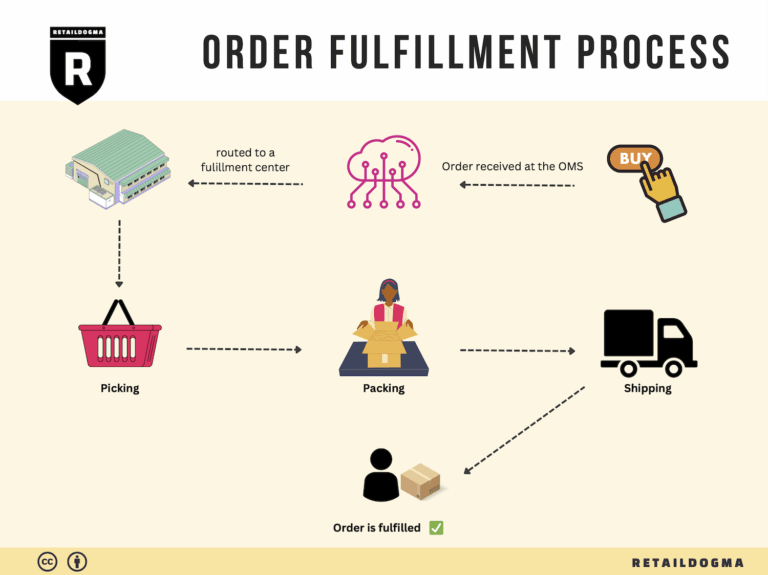What Is A Fulfillment Center? A Complete Guide (2025)
What is E-commerce Fulfillment? An Introduction for Growing Businesses
Understanding E-commerce Fulfillment: A Key to Scaling Your Business
As your online business begins to grow, the excitement of increased sales can quickly turn into a daunting challenge. One of the most common pain points for entrepreneurs and operations managers is managing the logistics of packing and shipping orders. The process of getting a product to a customer—known as fulfillment—can become overwhelming without the right systems in place. This is where understanding e-commerce fulfillment becomes essential for scaling your operations effectively.
Fulfillment refers to the entire process involved in receiving, processing, and delivering an order to the customer. It encompasses everything from inventory management and order processing to packing, shipping, and handling returns. As your business expands, the complexity of fulfillment increases, making it vital to have a clear strategy and the right partners in place.
In this guide, we will explore various models of fulfillment that can suit your growing business, including Third-Party Logistics (3PL) and Fulfillment by Amazon (FBA). Each model has its unique advantages and can cater to different business needs, allowing you to choose the best fit for your operations.
We will delve into the core services associated with e-commerce fulfillment, such as pick and pack services, warehousing solutions, shipping options, and returns management. Understanding these services will help you identify what you need to streamline your logistics and enhance customer satisfaction.
Choosing the right fulfillment partner is another critical aspect we will cover. Factors to consider include the partner’s technology capabilities, customer service, pricing structure, and the range of services they provide. A solid partnership can lead to improved efficiency and ultimately boost your bottom line.
Speaking of pricing, we will provide insights into how fulfillment costs are structured, including potential hidden fees and how to avoid them. Understanding the financial implications of your fulfillment strategy is crucial for maintaining profitability as you scale.
The goal of this guide is to empower you with the knowledge and tools needed to make informed decisions about your logistics. By streamlining your fulfillment processes, you can focus on what you do best—growing your business and delighting your customers.
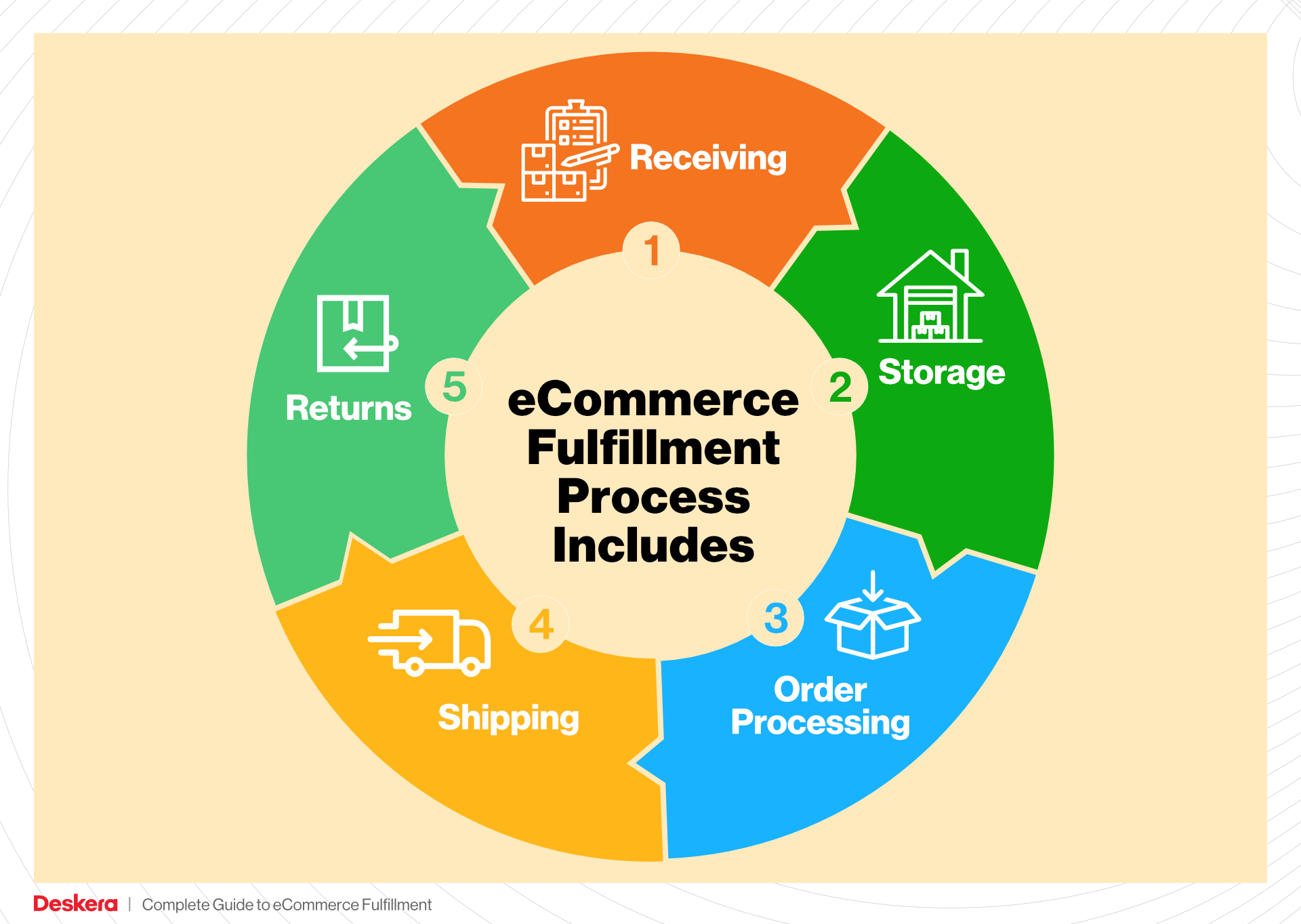
What You’ll Learn In This Guide
- What is E-commerce Fulfillment? An Introduction for Growing Businesses
- The Order Fulfillment Process: From ‘Buy’ Button to Customer’s Door
- Comparing Fulfillment Models: In-House vs. 3PL vs. Dropshipping
- A Deep Dive into Amazon FBA: Pros, Cons, and Who It’s For
- Core Services Offered by Fulfillment Centers
- How to Choose a Fulfillment Partner: A 6-Point Checklist
- Understanding Fulfillment Pricing: A Breakdown of Common Fees
- Frequently Asked Questions (FAQs) about Fulfillment
- Conclusion: Is Outsourcing Fulfillment the Right Move for Your Business?
- Important Disclaimer
The Order Fulfillment Process: From ‘Buy’ Button to Customer’s Door
1. Receiving Inventory
The order fulfillment process begins with receiving inventory, a critical first step that sets the tone for the entire operation. When products arrive at your fulfillment center, they are checked against purchase orders to ensure accuracy. This includes verifying quantities, inspecting for damage, and confirming that the correct items have been delivered.
Importance: Proper inventory receiving is crucial because it prevents discrepancies that can lead to stockouts or overstock situations. Accurate receiving helps maintain an efficient supply chain, ensuring that your business can meet customer demand without delays.
Key Term: SKU (Stock Keeping Unit) – Each product should have a unique SKU to streamline the receiving process. This identifier helps in tracking inventory levels, managing stock, and facilitating order processing.
2. Warehouse Storage
Once the inventory has been successfully received, it needs to be stored appropriately in the warehouse. Effective warehouse storage involves organizing products in a manner that maximizes space and facilitates easy access. This may involve using shelving, bins, or pallets, depending on the nature of the products.
Importance: Well-organized storage systems enhance operational efficiency by reducing the time it takes to locate and retrieve items. This is particularly important as your business scales; effective storage solutions can significantly impact the speed and accuracy of order fulfillment.
Key Term: ABC Analysis – A method of categorizing inventory based on importance, where “A” items are high-value or fast-moving, “B” items are moderate, and “C” items are lower-value or slow-moving. This approach helps prioritize storage space and retrieval processes.
3. Order Picking
Order picking is the process of selecting items from the warehouse to fulfill customer orders. This can be done using various methods, including single order picking (picking items for one order at a time) or batch picking (collecting items for multiple orders simultaneously).
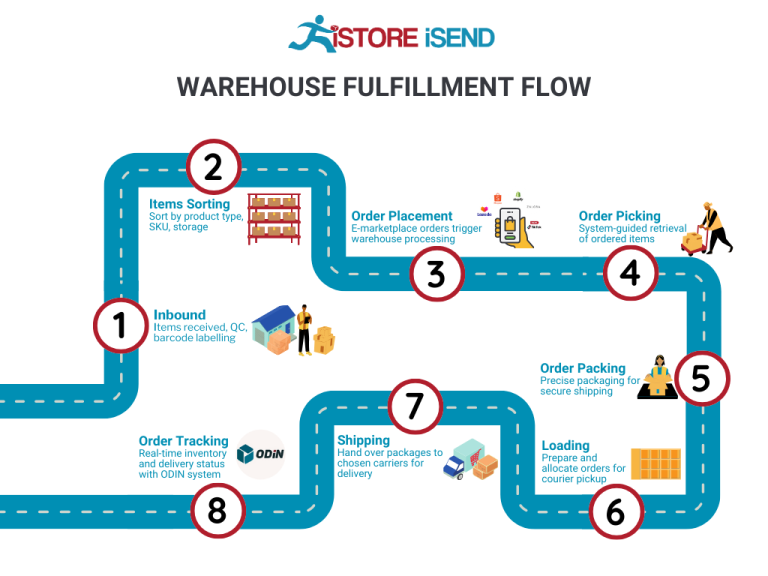
Importance: Efficient order picking is essential to minimize the time between receiving an order and shipping it out. Delays in this step can lead to unhappy customers and increased operational costs.
Key Term: Pick Lists – A document or digital tool that outlines the items to be retrieved for an order. Pick lists can include SKUs, quantities, and locations within the warehouse, streamlining the picking process and reducing errors.
4. Order Packing
After items have been picked, they are packed for shipment. This involves choosing the right packaging materials to protect products during transit while also considering branding elements that enhance the unboxing experience for customers.
Importance: Proper packing not only safeguards items but also reflects your brand’s image. Thoughtful packaging can lead to customer satisfaction and repeat business, as a positive unboxing experience can enhance the perception of your brand.
Key Term: Packing Slip – A document included in the shipment that lists the items contained in the package. This serves as a confirmation for the customer and helps ensure order accuracy.
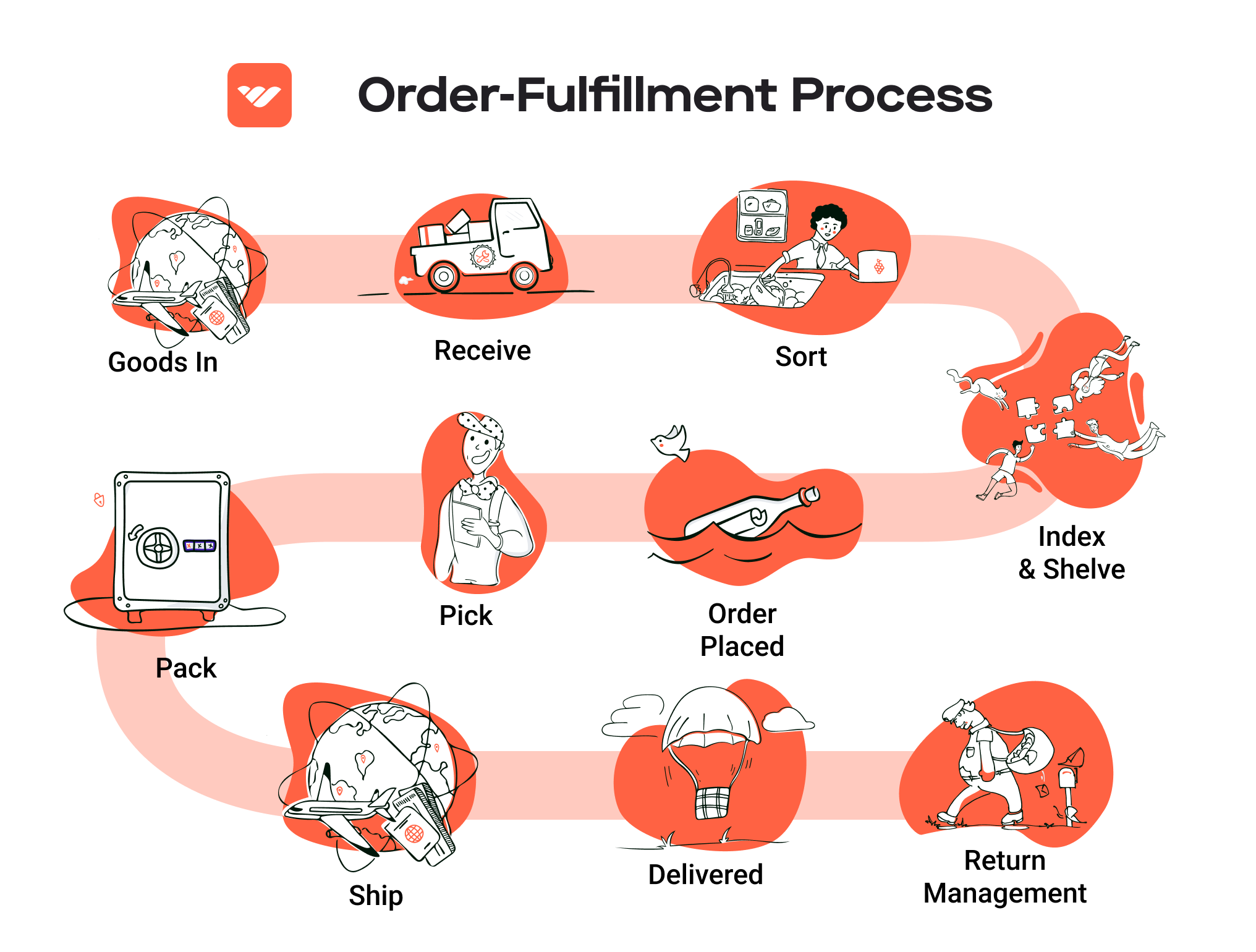
5. Shipping & Delivery
The final step in the order fulfillment process is shipping and delivery. This involves selecting the appropriate carrier based on factors such as cost, speed, and destination. Effective shipping strategies, including real-time tracking and efficient route planning, can greatly enhance the delivery experience.
Importance: Timely and reliable shipping is critical to customer satisfaction. With the rise of e-commerce, consumers expect fast delivery times, and your ability to meet these expectations can significantly influence their loyalty to your brand.
Key Term: Last-Mile Delivery – The final step of the delivery process, where the package is transported from a distribution center to the customer’s doorstep. This phase is often the most complex and costly, making it essential to optimize your logistics for efficiency.
Conclusion
Understanding and optimizing each step of the order fulfillment process is vital for e-commerce businesses looking to scale. By focusing on effective inventory management, organized storage, efficient picking, thoughtful packing, and reliable shipping, you can enhance customer satisfaction, reduce operational costs, and ultimately drive growth in your business.
Comparing Fulfillment Models: In-House vs. 3PL vs. Dropshipping
Fulfillment Model Comparison Table
| Model | Who Handles Inventory | Best For (Business Stage) | Key Advantage | Key Disadvantage |
|---|---|---|---|---|
| In-House Fulfillment | Business Owner/Staff | Established Businesses | Full control over operations | High overhead costs and complexity |
| Third-Party Logistics (3PL) | 3PL Provider | Startups to Growing SMBs | Scalability and expertise in logistics | Less control over fulfillment process |
| Dropshipping | Supplier/Vendor | Startups and Small Brands | Low upfront investment and risk | Lower profit margins and brand control |
In-House Fulfillment
In-house fulfillment involves managing the entire order fulfillment process within your own facility. This model is best suited for established businesses that have sufficient order volume and resources to maintain their own warehouse, staff, and logistics operations. The primary advantage of in-house fulfillment is the control it provides over the entire process, including inventory management, shipping methods, and customer service. This control can lead to enhanced customer experience, as businesses can tailor their operations to meet specific needs and preferences. However, this model also comes with significant disadvantages, such as high overhead costs associated with warehousing, staffing, and maintaining inventory. Additionally, as order volume fluctuates, businesses may struggle with scalability, leading to inefficiencies during peak seasons or overcapacity during slower periods.
Third-Party Logistics (3PL)
Third-party logistics (3PL) is a fulfillment model where businesses outsource their logistics and fulfillment operations to a specialized provider. This model is particularly advantageous for startups and growing small-to-medium businesses (SMBs) that seek to streamline their operations without the burden of managing physical inventory themselves. Key advantages of partnering with a 3PL include access to logistics expertise, reduced shipping costs due to established carrier relationships, and the ability to scale operations quickly in response to demand fluctuations. Additionally, many 3PL providers offer integrated technology solutions that allow businesses to monitor inventory and shipments in real-time, simplifying the fulfillment process. However, the main disadvantage is the potential loss of control over the fulfillment process. Businesses may find themselves dependent on the 3PL provider’s capabilities and responsiveness, which can impact customer satisfaction if not managed properly.
Dropshipping
Dropshipping is a fulfillment model where businesses sell products without holding any inventory. Instead, when a customer places an order, the business purchases the item from a third-party supplier, who then ships it directly to the customer. This model is particularly appealing for startups and small brands due to its low upfront investment and minimal risk. Entrepreneurs can launch e-commerce stores without the financial burden of purchasing inventory upfront, allowing them to focus on marketing and customer acquisition. However, dropshipping also has significant disadvantages, including lower profit margins due to reliance on supplier pricing and limited control over product quality and shipping times. Additionally, businesses may face challenges in building a strong brand identity since the product is often indistinguishable from competitors who may be using the same suppliers. This lack of control can result in customer dissatisfaction if products do not meet expectations or if shipping delays occur.
In summary, each fulfillment model presents unique advantages and disadvantages, making it crucial for e-commerce business owners and operations managers to carefully evaluate their specific needs and growth stages. Understanding the implications of each model will enable businesses to make informed decisions that align with their operational capabilities and long-term goals.
A Deep Dive into Amazon FBA: Pros, Cons, and Who It’s For
Understanding Fulfillment by Amazon (FBA)
Fulfillment by Amazon (FBA) is a service offered by Amazon that allows e-commerce sellers to store their products in Amazon’s fulfillment centers. Amazon takes care of storage, packaging, and shipping, as well as customer service and returns for these products. This can be a game-changer for e-commerce businesses looking to scale, as it enables sellers to leverage Amazon’s vast logistics network and customer base.
How FBA Works
-
Product Listing: Sellers create product listings on Amazon and choose FBA as their fulfillment method.
-
Inventory Shipment: Sellers send their products to Amazon’s fulfillment centers. Amazon provides guidelines on how to package and label these items.
-
Storage: Once the products arrive, they are stored in Amazon’s warehouses. Inventory is managed by Amazon, which keeps track of stock levels.
-
Order Fulfillment: When a customer places an order for a product, Amazon picks, packs, and ships the item on behalf of the seller. This process is typically very quick, often allowing for same-day shipping.
-
Customer Service: Amazon handles all customer inquiries and returns, allowing sellers to focus on other aspects of their business.
-
Multi-channel Fulfillment: Sellers can also fulfill orders from other sales channels (like their own website) through FBA, streamlining their logistics processes.
Pros of Fulfillment by Amazon
-
Prime Eligibility: Products fulfilled through FBA are eligible for Amazon Prime, which can significantly increase visibility and sales. Prime members are known for their higher purchasing rates, and having access to Prime can enhance the attractiveness of your listings.
-
Customer Trust: Amazon is a trusted brand with millions of users. By using FBA, sellers can benefit from the credibility associated with Amazon, which can lead to increased sales. Customers often feel more secure purchasing items backed by Amazon’s fulfillment services.
-
Multi-channel Fulfillment: FBA allows sellers to manage inventory across multiple sales platforms seamlessly. Whether selling on Amazon, their own website, or other marketplaces, businesses can use FBA to fulfill orders, simplifying logistics and inventory management.
-
Scalability: FBA is designed to grow with your business. As your sales increase, Amazon can handle the increased volume without requiring significant changes to your operations. This scalability makes it an attractive option for fast-growing businesses.
-
Simplified Logistics: By outsourcing storage, packing, and shipping to Amazon, sellers can focus on other areas of their business, such as marketing and product development. This can free up valuable time and resources.
Cons of Fulfillment by Amazon
-
High Fees: While FBA provides many benefits, the costs can add up. Sellers must pay storage fees for their inventory, fulfillment fees per item sold, and additional charges for long-term storage. These fees can significantly cut into profit margins, especially for lower-priced items.
-
Strict Inventory Rules: Amazon has stringent requirements regarding inventory management. Sellers must adhere to specific guidelines for labeling, packaging, and shipping their products. Failure to comply can result in additional fees or penalties.
-
Commingling Risks: When using FBA, sellers’ inventory may be commingled with that of other sellers. This means that if a customer receives a defective item from your inventory, it could damage your seller rating. Additionally, tracking and managing inventory can become more complicated, as it is not always clear which items belong to whom.
-
Limited Control Over Fulfillment: By relying on Amazon, sellers give up a degree of control over the fulfillment process. This can be a concern for businesses that prioritize custom packaging or unique shipping experiences for their customers.
-
Inventory Management Challenges: Managing inventory levels can be tricky with FBA. Sellers must carefully predict demand to avoid stockouts or excess inventory, both of which can incur additional costs.
Who is FBA Best For?
Fulfillment by Amazon is particularly well-suited for:
-
Startups and Small Businesses: Newer companies often lack the resources to manage their own warehousing and logistics. FBA allows them to scale quickly without significant upfront investment in infrastructure.
-
Established Sellers Looking to Scale: Businesses already selling on Amazon can leverage FBA to increase efficiency and reach a broader customer base without needing to handle logistics themselves.
-
Retailers with Seasonal Products: Companies that experience spikes in demand during certain times of the year can benefit from FBA’s scalability, allowing them to manage inventory more effectively during peak seasons.
-
Sellers with Diverse Product Lines: Those who sell a variety of products can use FBA to streamline their logistics across multiple categories, simplifying inventory management.
In summary, Fulfillment by Amazon offers a powerful solution for e-commerce businesses looking to enhance their logistics capabilities and scale effectively. While it presents certain challenges, the potential benefits—particularly in terms of customer trust, Prime eligibility, and simplified operations—often outweigh the downsides for many sellers.
Core Services Offered by Fulfillment Centers
Inventory Management & Warehousing
Effective inventory management and warehousing are critical components of any e-commerce operation. Fulfillment centers provide secure storage solutions that ensure your products are well-organized and easily accessible. This service encompasses the tracking of stock levels, monitoring inventory turnover, and managing replenishment to avoid stockouts or excess inventory.
The benefit of efficient inventory management is twofold. First, it enhances your ability to meet customer demand promptly, which is essential for maintaining high levels of customer satisfaction. Second, it minimizes holding costs associated with excess inventory, thereby improving your overall profitability. Advanced inventory management systems used by fulfillment centers allow for real-time data access, enabling e-commerce businesses to make informed decisions about stock levels, forecast demand, and plan for seasonal fluctuations. This level of control is particularly advantageous for businesses looking to scale, as it reduces the risks associated with inventory mismanagement.
Pick and Pack Services
Pick and pack services are at the heart of the fulfillment process. This involves the picking of individual items from the warehouse based on incoming orders, followed by careful packing to ensure that products arrive at their destination in pristine condition. Fulfillment centers utilize trained staff and efficient systems to streamline this process, which is often supported by technology such as barcode scanning and automated inventory tracking.
The primary benefit of robust pick and pack services is the speed and accuracy they bring to order fulfillment. With a high order accuracy rate, businesses can minimize costly errors that lead to returns and dissatisfied customers. Fast turnaround times in order processing also contribute to improved shipping times, which is a critical factor in today’s competitive e-commerce landscape. Moreover, effective pick and pack services can enhance the unboxing experience for customers, as fulfillment centers often offer customization options such as branded packaging and personalized notes, reinforcing brand loyalty.
Kitting and Assembly
Kitting and assembly services involve grouping individual items together to create a single, ready-to-sell product. This could include assembling products, bundling items for promotional purposes, or preparing subscription boxes. Fulfillment centers can handle the entire kitting process, saving e-commerce businesses time and labor costs.
The advantage of kitting is that it allows businesses to offer unique product combinations that may increase perceived value and drive sales. For instance, a company can create gift sets or themed bundles that cater to specific customer needs or seasonal trends. This service is particularly beneficial for businesses that sell complex products requiring assembly, as it ensures that the final product is delivered to the customer in a ready-to-use state. By outsourcing kitting and assembly, e-commerce businesses can focus on their core operations, such as marketing and product development, while ensuring that the logistics of product preparation are handled efficiently.
Returns Management (Reverse Logistics)
Returns management, or reverse logistics, is a vital service provided by fulfillment centers to handle the inevitable returns that come with e-commerce. This service encompasses the entire process from receiving returned items to inspecting, restocking, and processing refunds or exchanges. A streamlined returns management system is essential for maintaining customer satisfaction and loyalty.
The benefits of effective returns management are significant. Firstly, a smooth returns process can enhance the customer experience, making them more likely to shop with you again. E-commerce businesses that make returns easy often see lower customer churn rates and increased repeat purchases. Furthermore, an efficient returns management system helps businesses recover value from returned products through restocking or refurbishing, thus minimizing losses. With advanced tracking and reporting capabilities, fulfillment centers provide businesses with insights into return reasons, which can inform product quality improvements and reduce future return rates.
In conclusion, the core services offered by fulfillment centers are designed to streamline operations, enhance customer satisfaction, and ultimately support the growth of e-commerce businesses. By leveraging these services, business owners can focus on strategic initiatives while ensuring that their logistics and fulfillment processes operate seamlessly.
How to Choose a Fulfillment Partner: A 6-Point Checklist
Location & Warehouse Network
Importance:
The location of your fulfillment partner’s warehouses significantly impacts shipping times and costs. A strategically located warehouse network can help minimize transit times to your customers, thereby enhancing customer satisfaction and reducing shipping expenses.
Questions to Ask:
– Where are your warehouses located, and how do they align with our customer demographics?
– What is your shipping coverage area (domestic and international)?
– Do you have plans for expanding your warehouse network in the future?
Technology & Integrations
Importance:
Robust technology is essential for streamlined operations. A fulfillment partner should offer a user-friendly platform that integrates seamlessly with your existing e-commerce systems. This integration ensures real-time inventory management, order tracking, and overall operational efficiency.
Questions to Ask:
– What technology do you use for inventory management and order processing?
– Can your system integrate with our existing e-commerce platform or shopping cart?
– Do you offer real-time tracking and reporting features? How accessible is this data?
Specializations (e.g., cold storage, oversized items)
Importance:
Depending on your product offerings, you may require specialized services. For instance, if you sell perishable goods, a fulfillment partner with cold storage capabilities is essential. Similarly, if your products are oversized or require special handling, ensure that the partner has the necessary facilities and expertise.
Questions to Ask:
– What specializations do you offer (e.g., cold storage, hazardous materials, oversized items)?
– Can you provide examples of how you’ve successfully managed similar product types?
– What safety and compliance measures do you have in place for specialized inventory?
Scalability & Capacity
Importance:
As your business grows, your fulfillment needs will likely change. Choosing a partner that can scale with your business is crucial for avoiding disruptions. This includes their capacity to handle increased order volumes and their flexibility in adapting to seasonal spikes in demand.
Questions to Ask:
– What is your current capacity for handling orders, and how do you manage peak seasons?
– How quickly can you scale operations if our order volume increases significantly?
– Do you have a plan in place for managing inventory during seasonal fluctuations?
Pricing and Contracts
Importance:
Understanding the pricing structure and contract terms is vital to avoid unexpected costs. Look for transparency in pricing and ensure that there are no hidden fees. Flexible contract terms can also provide you with the freedom to change partners if necessary.
Questions to Ask:
– What is your pricing model (e.g., per order, monthly fees, storage fees)?
– Are there any hidden fees we should be aware of (setup fees, integration fees, etc.)?
– What are the terms of your contracts? Is there flexibility for scaling up or down?
Customer Support & Reviews
Importance:
Strong customer support is essential for addressing issues quickly and effectively. A fulfillment partner should be responsive and proactive in helping you resolve any challenges that arise. Additionally, reviews and testimonials from current or past clients can provide insights into their service quality.
Questions to Ask:
– What kind of customer support do you offer (e.g., dedicated account manager, 24/7 support)?
– How do you handle issues or discrepancies in order fulfillment?
– Can you provide references or case studies from businesses similar to ours?
Conclusion
Choosing the right fulfillment partner is a critical decision that can significantly impact your e-commerce operations and customer satisfaction. By carefully evaluating potential partners against this checklist, you can make an informed choice that aligns with your business goals and growth trajectory. Prioritize partners that demonstrate a strong commitment to quality, flexibility, and customer service, ensuring a successful partnership as your business scales.
Understanding Fulfillment Pricing: A Breakdown of Common Fees
Initial Setup Fees
Initial setup fees are often a one-time charge that covers the costs associated with integrating your e-commerce platform with the fulfillment service. This may include the configuration of software, inventory management systems, and any necessary training for your team. These fees can vary widely based on the complexity of your operations and the level of customization required.
Some fulfillment centers, especially those aiming to attract small and medium-sized businesses, may waive these fees entirely to encourage new clients. Always ask if setup fees are applicable and seek clarity on what services are included in this charge.
Receiving Fees
Receiving fees are charged for the process of accepting and processing your inventory when it arrives at the fulfillment center. This fee typically covers the labor involved in unloading, inspecting, and entering items into the inventory management system.
Receiving fees are usually calculated based on the number of pallets or individual items received. For example, a fulfillment center might charge a flat fee per pallet or a fee per hundred items, which can vary significantly between providers. Understanding how a fulfillment center assesses receiving fees can help you anticipate costs and manage your inventory flow more efficiently.
Storage Fees (per pallet/bin)
Storage fees are incurred for the space your inventory occupies within the fulfillment center. These fees can be charged on a per-pallet or per-bin basis, depending on how the warehouse is structured.
Typically, storage fees are calculated monthly and can vary based on the type of goods stored and the duration of storage. Some facilities may offer tiered pricing based on the volume of goods or seasonal discounts during slower months. It’s crucial to review the storage policies of potential fulfillment partners, as hidden fees can significantly affect your overall operational costs.
Pick & Pack Fees (per item/order)
Pick and pack fees are charged for the labor involved in selecting items from inventory and packing them for shipment. This fee can be calculated per item or per order, depending on the fulfillment service’s pricing model.
For example, a fulfillment center might charge a specific fee for each item picked and packed, or a flat fee per order that includes a certain number of items. Understanding how these fees are structured can help you estimate costs based on your average order size and frequency. Additionally, some providers may offer discounts for larger orders or recurring shipments, which can be beneficial for scaling businesses.
Shipping Fees
Shipping fees encompass the costs associated with transporting your products to customers. These fees can vary widely based on factors such as package weight, dimensions, shipping method (standard, expedited, international), and the destination.
Fulfillment centers often have partnerships with major carriers, which can lead to discounted shipping rates that may not be available if you were to ship independently. It’s important to understand how shipping fees are calculated and whether they are passed directly to you or if the fulfillment center absorbs some of the costs. Additionally, inquire about any surcharges for specific destinations or service levels to avoid unexpected expenses.
Tips for Getting an Accurate Quote
When seeking fulfillment services, obtaining an accurate quote is crucial for budgeting and financial planning. Here are some practical tips:
-
Provide Detailed Information: Clearly outline your business model, average order size, product types, and expected order volume. The more information you provide, the more accurate the quote will be.
-
Ask About Hidden Fees: Inquire about any potential hidden fees, such as those for returns, packaging materials, or additional services. Transparency is key to understanding your total costs.
-
Request a Breakdown: Ask for a detailed breakdown of all fees associated with the fulfillment service. This should include initial setup, receiving, storage, pick & pack, and shipping fees.
-
Compare Multiple Providers: Don’t settle for the first quote you receive. Compare offers from multiple fulfillment centers to gauge the average pricing and service levels in the market.
-
Consider Seasonal Variability: If your business experiences seasonal fluctuations, ask how fees may change during peak seasons, and whether there are strategies to mitigate higher costs during these times.
By understanding the various fees associated with fulfillment and applying these tips, you can make informed decisions that align with your business goals and help you scale effectively.
Frequently Asked Questions (FAQs) about Fulfillment
1. What is e-fulfillment?
e-fulfillment refers to the complete process of receiving, processing, and delivering customer orders for e-commerce businesses. This includes inventory management, order picking and packing, shipping, and handling returns. An efficient e-fulfillment strategy is crucial for enhancing customer satisfaction and operational efficiency.
2. What is the difference between a warehouse and a fulfillment center?
A warehouse primarily serves as a storage facility for goods, focusing on inventory management and bulk storage. In contrast, a fulfillment center is specifically designed to handle the logistics of e-commerce, including order processing, picking, packing, shipping, and returns management. Fulfillment centers are equipped to handle high order volumes and quick turnaround times.
3. What is a 3PL (Third-Party Logistics)?
A 3PL is a company that provides outsourced logistics services, including warehousing, transportation, and fulfillment. By partnering with a 3PL, e-commerce businesses can leverage the expertise, technology, and resources of the logistics provider to scale operations without the need for significant investment in infrastructure.
4. How much do fulfillment services cost?
The cost of fulfillment services can vary widely based on several factors, including the size and weight of products, order volume, storage needs, and additional services like kitting or custom packaging. Many fulfillment providers offer pricing structures that include per-order fees, storage fees, and shipping costs. It’s essential to request quotes from multiple providers to compare costs effectively.
5. How can I choose the right fulfillment partner for my business?
When selecting a fulfillment partner, consider factors such as their experience in your industry, service offerings, technology integration capabilities, pricing structure, and customer support. Additionally, look for reviews and testimonials from other clients to gauge their reliability and performance.
6. What services do fulfillment centers typically offer?
Fulfillment centers usually provide a range of services, including inventory storage, order picking and packing, shipping and delivery, returns processing, kitting, and customer support. Some centers also offer specialized services such as international shipping and integration with various e-commerce platforms.
7. How do fulfillment centers handle returns?
Fulfillment centers manage returns through a structured process that includes receiving returned items, inspecting their condition, restocking items if applicable, and updating inventory records. A well-managed returns process is essential for maintaining customer satisfaction and minimizing losses.
8. What technology is involved in e-fulfillment?
Modern e-fulfillment relies on various technologies, including inventory management systems, order management systems, and shipping software. These technologies enable real-time tracking of inventory levels, order statuses, and shipping updates, allowing businesses to operate efficiently and provide transparency to customers.
9. Can I scale my business with a fulfillment service?
Yes, utilizing a fulfillment service can significantly enhance your ability to scale. With flexible storage options, efficient order processing, and access to a broad shipping network, fulfillment partners can support your growth without the logistical challenges of managing operations in-house.
10. How do I integrate my e-commerce platform with a fulfillment service?
Most fulfillment services offer integration capabilities with popular e-commerce platforms through APIs or plugins. You can typically connect your online store to the fulfillment center’s system, allowing for seamless order processing, inventory updates, and tracking information. Check with your chosen fulfillment partner for specific integration options and support.
Conclusion: Is Outsourcing Fulfillment the Right Move for Your Business?
Evaluating the Benefits of Outsourcing Fulfillment
Outsourcing your fulfillment operations can be a transformative decision for your e-commerce business. First and foremost, partnering with a professional fulfillment service can significantly save you time. Instead of grappling with inventory management, packing, and shipping logistics, you can focus on core business activities such as product development and marketing. This shift in focus can lead to enhanced innovation and growth, allowing you to better serve your customers.
Scalability is another compelling advantage. As your business grows, so do your logistical needs. A reliable fulfillment partner can scale alongside your business, accommodating increased order volumes without the need for you to invest in additional warehousing or staff. This flexibility is especially valuable during peak seasons or product launches, where demand can fluctuate dramatically.
Moreover, leveraging the expertise of a fulfillment provider brings an added layer of efficiency. Established fulfillment centers have streamlined processes, advanced technology, and industry knowledge that can enhance accuracy and reduce shipping costs. Their experience in navigating logistics, including international shipping and returns management, ensures that your operations remain smooth and customer satisfaction stays high.
However, the choice of fulfillment partner is critical. Not all providers offer the same level of service or capabilities, so conducting thorough research and due diligence is essential. Look for partners with a proven track record, transparent pricing, and robust customer support.
Take Action
To determine if outsourcing fulfillment is the right move for your business, conduct a thorough audit of your current shipping processes. Assess your operational pain points, customer feedback, and potential growth opportunities. This evaluation will help you make an informed decision on whether a fulfillment partner could enhance your efficiency and profitability. Take the first step today towards streamlining your logistics and propelling your business to new heights.
Important Disclaimer
⚠️ Important Disclaimer
The information in this guide is for educational purposes. Fulfillment services, pricing, and platform features change frequently. Always conduct your own due diligence and consult with providers directly before making business decisions.
